















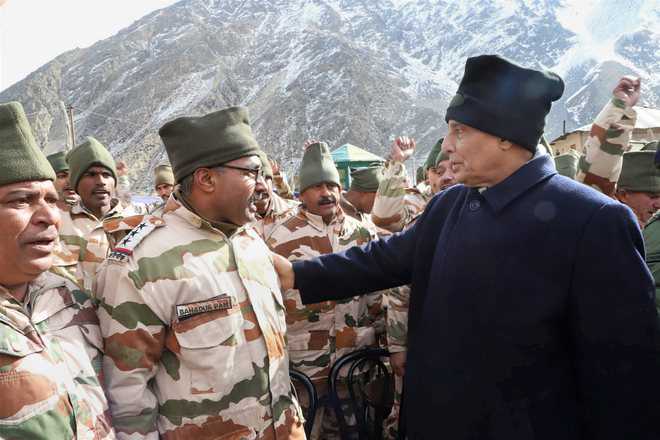
Nelong Valley (U’khand), Jan 1The Centre has undertaken a special project to connect all the border posts along the Sino-India frontier with roads, Union Home Minister Rajnath Singh said today as he reviewed the operational preparedness of a forward ITBP unit here.Singh ringed in the New Year with the troops of the Indo-Tibetan Border Police (ITBP) at this border post located at a height of 11,614 feet in Uttarakhand, where the mercury dropped to minus 20 degrees Celsius today. This was the first time a Home Minister or a senior Union minister paid a visit to this border post.The minister also instructed the ITBP personnel, in the presence of the force’s Director General (DG), RK Pachnanda, to find out ways to rotate the troops at such high-altitude posts in less than three months’ time. Currently, the troops are rotated every three months.This would enhance the operational efficiency of the personnel and also reduce the instances of mountain-related sickness among them, he said. “I have come here to see the conditions in which the ITBP jawans are guarding the Sino-India border,” the minister said. Wishing the personnel of the border guarding force a happy new year, Singh talked about his idea of reducing the current three months’ time of rotating the troops at such arduous and tough posts.“I will urge the ITBP to find ways and see how we can reduce the time period of deployment of troops, from three months to the least possible, as a lot of time is also spent on commuting to and from such hard areas,” he said.Heaping praise on the jawans and officers of the force, the minister said any amount of facilities provided to them would be less, considering the challenging terrain and nature they had to deal with. He added that the Centre had recently decided that the light-weight, special winter clothing, which was earlier provided to the troops posted at an altitude of above 14,000 feet, would now also be provided to the jawans posted at a height of over 9,000 feet.On Chinese incursion, he said the ITBP was successful in preventing such incidents. “China is our neighbouring country and we have good relations with them. India has always tried to maintain good relations with its neighbours,” the minister said. — PTI
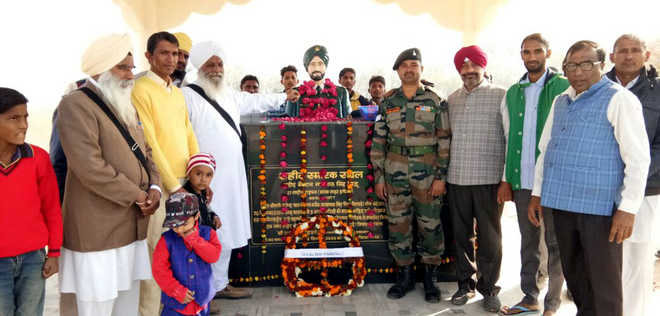
Abohar, December 31
Tributes were paid today to Captain Navpal Singh Sidhu on his 15th Balidan Diwas at his memorial located outside his native village 40 RB, near Padampur in Sriganganagar region.Havildar Ashok Rokade arrived from Kolhapur to lay a wreath at the memorial on behalf of the 19 Maratha Light Infantry Commanding Officer, Col Manish Tiwari. A ‘sehaj path’ was also performed in the village gurdwara. Rokade had served with Sidhu for two years before the ambush. “The Army is proud of such brave hearts,” Colonel Tiwari said in a message. Captain Navpal Singh Sidhu of the 19 Maratha Light Infantry was killed in 2002 after he gunned down three PoK-trained terrorists in the Surankote area of Poonch region in Jammu and Kashmir. He was awarded the Shaurya Chakra posthumously. His father, Lt Col Agyapal Singh Sidhu, had earlier led the offensive against the Pakistani army in 1965 and 1971. — OC
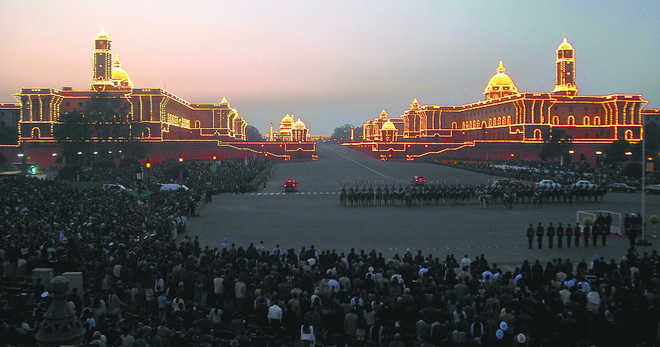
Lighting up hearts: An almost six-decade-old ceremony, it was initially conceived in 1961 to mark Queen Elizabeth II’s first state visit to India after Independence Tribune Photos and agencies
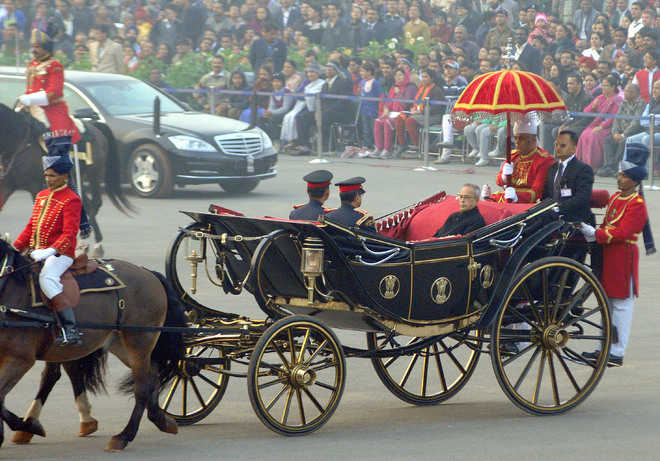
The President, the chief guest at the Beating Retreat ceremony, arrives in an antique nine-decade-old coach; Marching bands from the Army, Navy and Air Force during the ceremony that marks the culmination of the four-day long Republic Day celebrations
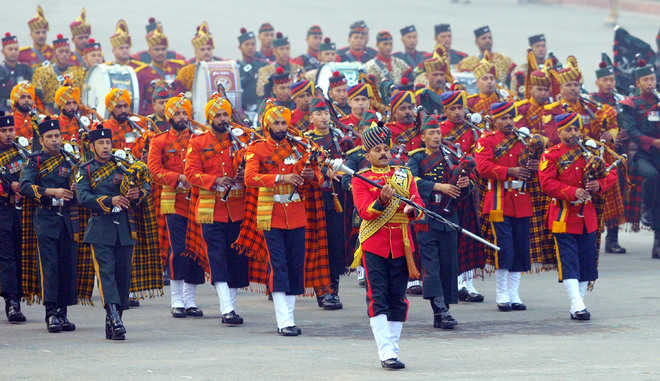
THe sombre and yet flamboyant performances by the bands of the three wings of the defence forces, the Army, the Navy and the Air Force, and pipe bands from the Army, (and since 2016, a massed formation of bands of the Central Armed Police Forces and the Delhi Police), bring to an end the four-day-long Republic Day celebrations on January 29. Those who have never witnessed this magic one-hour event, perhaps among the few such events in the world, should book a seat right away.
The audience comprises several thousand Indians, right from the common man up to the heads of the country’s Legislature, the Executive, the Judiciary, foreign dignitaries and guests from various diplomatic missions. There is a specially created, open amphitheatre near Vijay Chowk where people are expected to be seated 20 minutes before the commencement of the ceremony.
Around this time of the year, a gossamer mist usually softens the sharp edges of the minarets of the South and North Blocks and cloaks the central dome of Rashtrapati Bhavan in velvety smoothness. That is the surreal setting almost every year, when the President of India, who is the chief guest of the event, emerges from one of the grandest presidential residences in the world. He descends down a broad flight of steps, to receive the Presidential Salute from his Mounted Body Guards before alighting the State Coach, drawn by six horses. The coach in itself is a work of art and antiquity of over 90 years. The exterior of the coach, finished in black ebony and trimmed in silver piping, looks spectacular. It is harnessed to black horses (each with a diamond-shaped white birthmark in the middle of forehead), creates a grand contrast as majestic-looking animals go trotting over the brick-red pathway.
In clock-work precision, two posses of eight trumpeters (four from the Army and two each from the Navy and the Air Force), in ceremonial full dress, signal the passage of the cavalcade in between the North and South Blocks, first with a ‘Fanfare of Trumpets’ followed moments later by the music score, “Herald the Chief”. The statuesquely trumpeters, beneath the domes surmounting the two domineering towers of North and South Blocks, directly above the Vijay Chowk, look quite captivating.
Adding to the ceremonial ambience is a picked contingent from the President’s Mounted Body Guard, attired in scarlet tunics, intricately worked with gold lace and contrasting, white mole-skin breeches, astride well groomed and manicured horses. It is a tradition that goes back to the Madras Governor General’s Guard, raised way back in 1773. The Commandant of the Guard, facing the President, orders the National Salute and the massed bands strike up the National Anthem as the Tricolour is hoisted at the venue. The silent audience bursts in vigorous clapping, with maybe a few misty eyes here and there and almost every face wearing a broad smile, symbolic of the enduring spirit of India.
Over the next forty-five minutes, the audience cannot help but tapping their feet to the rhythm of martial music. The underlying theme of every tune is based on patriotism and glory of the Republic, such as “Kadam kadam badhaye chal, khushi ke geet gaya chaal, yeh zindgi hay kaum ki tu kaum par lootaye chal.” As though to fortify this resolve, they next play the rousing “Dhawaj kay rakshak”, (a motivational marching song, with lyrics by Capt Ram Singh and music by Maj HP Brar of the Army). The “Drums Roll”, which follows, creates an auditory crescendo of the thunder and volley and the clash of swords on the battle field.
The ultimate track is a favourite hymn of Mahatma Gandhi. As the sun tips over the horizon, the soldier-bandsmen translate this Biblical hymn into solemn music.
“Abide with me, fast falls the eventide
The darkness deepens Lord, with me abide
When other helpers fail and comforts flee
Help of the helpless, oh, abide with me …”
The Army Music School, which is part of the Army Education Corps, over time have successfully adapted the inherited western martial music to Indian sensibilities. Of late, they even showcase a few de novo music scores using instruments unknown to martial music, such as the tabla, sitar, violin, flute, oboe and even jaltarang. These orchestra creations are remarkably pleasing and the “Salam to the soldier” in particularly, is quite stirring. However, none of them classify as the martial music to march to.
As the “Last Post” is played, and the National Flag is lowered, some four hundred battle-inoculated, soldier-bandsmen wearing immaculate ceremonial uniforms, symbolising their loyalty to the country and a heritage of valour, march up the Raj Path playing to perfection …
“Saare Jahaan Se Accha
Hindustaan Hamaara
Ham Bulbulain Hai Is Ki,
Yeh Gulsitaan Hamaara …”
As though to underline this feeling, the Rashtrapati Bhavan, North and South Blocks, Houses of Parliament are floodlit. Simultaneously, the lotus fountains at Vijay Chowk cascade water in the colours of the National Flag, embodying the idea of India and spirit of Indians.
A colonial legacy
The Beating Retreat ceremony, grand finale to the Republic Day celebrations, was the brain child of India’s first Prime Minister, Pandit Jawahar Lal Nehru. It began in 1961. The idea was occasioned by the first state visit of Queen Elizabeth II and Prince Philip after Independence.As the British monarchy is intimately associated with military ranks, uniforms and ceremonials, the Indian Army was given the task of developing a display by the massed bands of the Army, the Air Force and the Navy consisting of pipes, drums, buglers and trumpeters from various regiments. The colourful ceremony has since become an annual official practice with the President of India as its chief guest
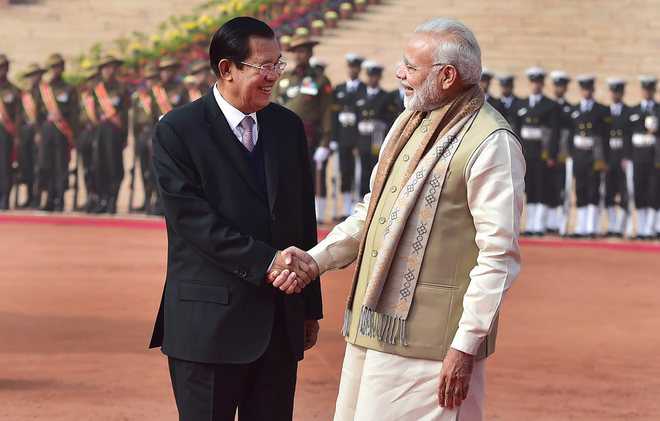
Smita Sharma
Tribune News Service
New Delhi, January 27
Continuing with his diplomatic engagement with ASEAN leaders, Prime Minister Modi today held delegation-level talks with Cambodian PM Samdech Hun Sen.The two sides discussed cooperation in development partnership, defence, trade and investment, energy conservation, agriculture and tourism. Four MoUs were signed, including mutual legal assistance in criminal matters. The delegations discussed the possibility of extending the India-Myanmar-Thailand trilateral highway further to Cambodia and beyond and expand air connectivity.(Follow The Tribune on Facebook; and Twitter @thetribunechd)Resonating with the Delhi Declaration issued after the ASEAN-India summit, the India-Cambodia joint statement stressed on “security of sea lanes of communication to maintain peace and ensure safety and security of navigation in the Indo-Pacific region”. “They also agreed that peace and maritime security is important for both countries. To that end, they support complete freedom of navigation and overflight and pacific resolution of maritime issues based on international law notably the 1982 UNCLOS,” added the joint statement.Earlier on Friday, Modi held bilateral discussions with Indonesian President Joko Widodo. Indonesia has proposed to invite countries in the region to discuss the Indo-Pacific concept.The two sides sought to strengthen the Indian Ocean Rim Association. “The Indonesian President lent his support for the concept of Indo-Pacific during his meeting with Modi,” said Preeti Saran, Secretary East in MEA. Defence, security, trade and investment, counter terrorism and people-to-people links figured prominently in Narendra Modi’s bilateral meeting with Malaysian Prime Minister Najib Razak.
Ink four pacts
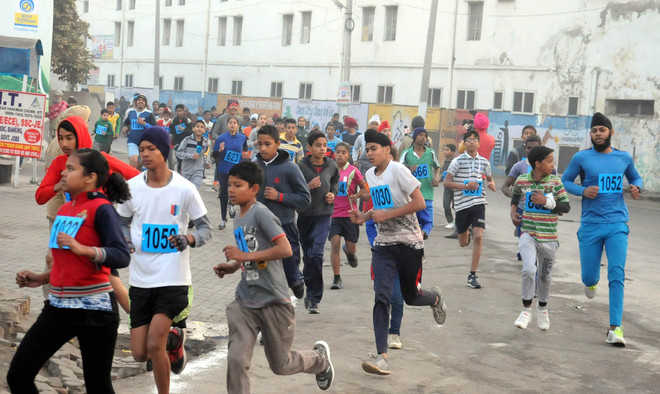
Tribune News Service
Bathinda, January 22
The Chetak Corps of the Indian Army has organised Chetak Mini-Marathon called “Lets run for the nation” to celebrate 70th Indian Army Day here today. The event was flagged off by Brigadier Tarundeep Kumar, Station Commander from Multipurpose Stadium. The DC and various other senior civilian dignitaries were also present.A total of 1,379 participants, including 342 children and 66 women, took part in the marathon with zeal and enthusiasm. The winners of the marathon were felicitated by Lieut-Gen PC Thimmaya, General Officer Commanding, Chetak Corps.In the 10 km category, the first prize was bagged by Lance Naik Mohkan Singh, second by Mr Preet Pal Singh and third by Gunner Arvind Kumar. In the 5 km category, the first prize was bagged by Sumit Awasti, second by Gurukumal Singh and third by Mohmmad Hamza.
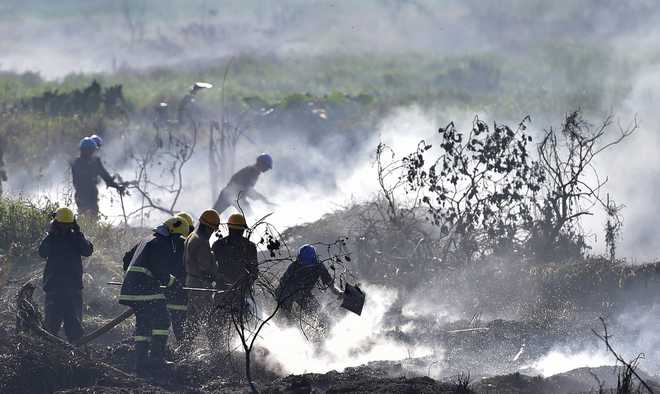
Firefighters try to put out fire at Bellandur Lake in Bengaluru on Saturday. Bellandur Lake, known for its high levels of pollution, caught fire on Friday morning billowing huge clouds of smoke on the Yemlur side of the lake. PTI
Bengaluru, January 20
Black smoke continued to billow from the Bellandur Lake on Saturday, hours after a huge fire close to a nearby Army firing range was doused in a massive operation involving more than 5,000 armymen and fire fighters.
“Major fire that was there yesterday has been doused, but there is still smoke emerging in some small pockets,” a senior fire department official said.
He said they were now trying to ensure that the embers from which the smoke emanated do not re-ignite due to wind.
Water from the lake was used to put off the fire, the cause of which would be known after investigations, officials said.
The blaze started on Saturday in the highly polluted and biggest water body of the city, giving anxious moments to hundreds of residents living nearby before it was doused last night.
It had also spread towards the nearby Iblur firing range of the Army, the officials said.
The Army last night said the fire, which had spread to the perimeter of its facility, had been doused due to the untiring efforts of more than 5,000 of its personnel and fire fighting equipment of the Army Service Corps (ASC) Centre and College.
Lt Gen Vipin Gupta, commandant ASC Centre and College, said on Saturday that things were under control.
As voices were emerging that the fire may have started due to methane burst as a result of accumulation of chemicals and pollutants in the lake, authorities also suspect the involvement of local grass harvesters in starting it.
Fire department officials said the reason behind the fire has not yet been determined and their priority was to put off the fire completely. “Later, investigation will be done to know the cause of fire,” a senior official said.
Speaking to reporters after visiting the site this morning, Lt. Gen. Gupta said: “The area that is close to our camp is absolutely under control, there is nothing. The area that is close to the lake there is still lot of smoke, but it is under control”.
“We have a lot of fire tenders there and we are ready for any eventuality,” he said.
Lt. Gen. Gupta said this was the first time the blaze had spread to their camp. “It had never interfered with our activities, but now that it has come very close to us we will definitely take up the case with civil authorities,” he said.
Asked if the Army will take up the lake’s cleaning, he said they were always ready to help the civil administration.
But as far as cleaning was concerned “it is a very technical and professional job” for which people were available on the civil side, he added.
Spread over 1,000 acres near the infotech hub, the lake is highly contaminated as it receives 60 per cent of the sewage generated in the city. It is in bad shape despite the National Green Tribunal pulling up the government and its various agencies for failing to prevent pollution and not doing enough to restore the lake.
The Bellandur lake had caught fire in May 2015 and August 2016 also.
In 2015, the lake had turned into a frothy, foam-filled water body due to high concentration of pollutants in the waters. Foam from the lake spilling onto nearby roads and surrounding areas had become a common sight each time the city received heavy rainfall.
The nearby Varthur lake was also in the focus when it caught fire in May 2017. PTI

A woman shows mortar shells that landed outside her house. Tribune photo: Inderjeet Singh

Damage due to cross-border shelling by Pakistan in RS Pura sector. Tribune photo:Inderjeet Singh
Family members of Ghara Singh of Bera village. Tribune Photo:Inderjeet Singh
An injured in a hospital. Tribune photo: Inderjeet Singh
Locals move towards safer place in RS Pura. Tribune photo: Inderjeet Singh
A man takes shelter in a bunker. Tribune photo: Inderjeet Singh

Mandeep Singh
Amir Tantray
Tribune News Service
Jammu, January 20
Three people, including an Army jawan, were killed and six injured in firing by Pakistani troops along the International Border (IB) and Line of Control (LoC) in Jammu division for the third day on Saturday.
Nine persons have been killed so far in ceasefire violations over three days.
(Follow The Tribune on Facebook; and Twitter @thetribunechd)
An Army jawan was today killed after being hit by a bullet during cross-border firing in Krishna Ghati sector of Poonch district.
The Tribune staff photographer Inderjeet Singh had a narrow escape when shells landed near Jora farms where he was shooting the damage occurred to temporary sheds of Gujjars.
Read: Soldier, BSF man, 2 civilians dieCentre must take effective measures to end cross-border firing: JKPCCResidents of border hamlets living in fear due to Pak firingOpposition stages walkout from Assembly over ceasefire violations
A defence spokesman identified the slain soldier as sepoy Mandeep Singh (23), a resident of Alampur village of Sangroor in Punjab.
He said the Pakistani Army initiated unprovoked and indiscriminate firing of small arms and automatics form 0820 hours in Krishna Ghati sector, resulting in grievous injuries to Singh who later succumbed.
The Indian Army retaliated strongly and effectively, the spokesman said.
The officials said two civilians, Gaura Ram (17) of Kapur R S Pura and Gour Singh (45) of Abdullian, were killed and five others injured in firing by Pakistani rangers along the IB in Jammu district.
A BSF spokesman said cross-border firing was underway in the area from Octroi to Chenab (Akhnoor) in Suchetgarh sector of R S Pura from this morning.
He said the firing in R S Pura sector stopped around 1.30 am but resumed again after four hours.
He said a BSF jawan in Pargwal sector was injured in the heavy firing and shelling and was later hospitalised.
The BSF is retaliating and the exchange of fire between the two sides was underway till the last reports were received.
A jawan of the Sashastra Seema Bal (SSB) was injured in cross border shelling in Jammu, officials said. The jawan, constable Lallu Ram, was evacuated to a nearby hospital and was said to be stable.
The jawan, who belongs to the 14th battalion of the force, was deployed for rendering law and order duties along with the Jammu and Kashmir Police at the Kanachak police station, when he was hit by splinters of a mortar shell that landed in the area.
While a BSF jawan and a teenaged girl were killed on Thursday, four people–two civilians and one BSF jawan and an Army jawan–were killed and over 40 others, including two BSF personnel, injured in the Pakistani firing yesterday.
The heavy firing had forced thousands of border residents to flee their homes and authorities announced closure of educational institutions for three days along the LoC and IB.
Between 8,000 to 9,000 people living along the IB have migrated to safer places and most of them were living with their relatives, officials said.
Over 1,000 people are housed in camps in R S Pura, Samba and Kathua areas, they said. With PTI inputs



























































